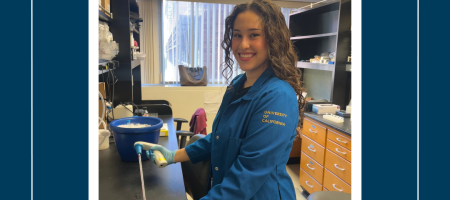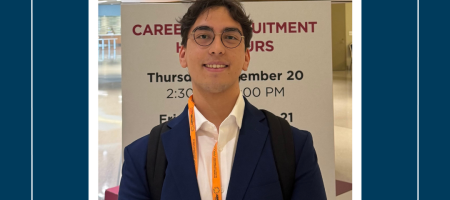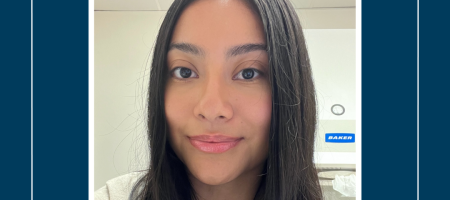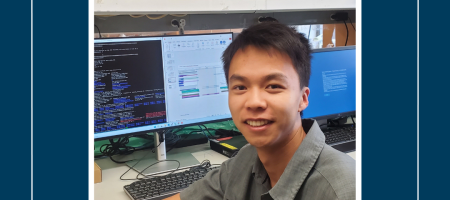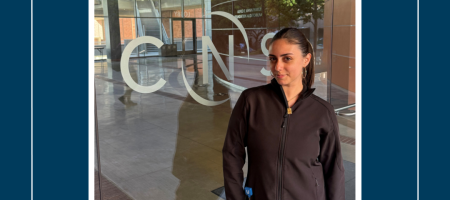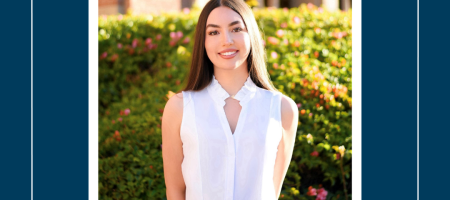Clarissa Carrillo
STUDENT SPOTLIGHT
Meet Clarissa Carrillo! Clarissa is a fourth-year Biology major looking to pursue a PhD and aspire to conduct research in the field of dermatology to contribute to a better understanding of skin diseases and the development of new treatments. She has been involved in the Program for Excellence in Education and Research in the Sciences (PEERS), the URC-Sciences Summer Program, and the Louis Stokes California Alliance for Maximizing Potential (CAMP). Clarissa credits undergraduate research to having a significant impact on her career path and has motivated her to pursue graduate school.
1. How did you first get involved in your research project? Tell us a bit about the lab you are in and the research you are conducting!
I was first introduced to research through PEERS and began applying to labs at the end of my sophomore year. I then joined the Mitochondrial Metabolism and Bioenergetics Lab under Dr. Ajit Divakaruni at the beginning of my junior year, where we study how mitochondrial function influences cellular signaling and fate decisions. I spent my first year of research working with my mentor on various projects, but was fortunate enough to start my own project in my lab the following summer through the URC-Sciences Summer Program. My project is ongoing and examines how metabolic pathways shift during neuronal differentiation, particularly through changes in TCA cycle intermediates, using stable isotope tracing and GC-MS analysis.
2. How would you describe your research experience at UCLA?
My research experience at UCLA has been extremely rewarding and eye-opening. It has allowed me to grow as a scientist, gain confidence in my abilities, and learn how to think critically about the questions I’m studying. I’ve also been able to work closely with supportive mentors, develop various technical skills, and contribute to meaningful research. Being a part of such a supportive and collaborative lab has truly made my research experience one of the most fulfilling and memorable parts of my time at UCLA.
3. What is your year and major?
I am a 4th year Biology major.
4. What is one piece of advice you have for other students thinking about getting involved in research?
The biggest piece of advice I can give to students thinking about getting involved in research is to just go for it! Although it can seem daunting at first, it is incredibly rewarding, and your PI and mentor are there to help you learn. When I first started, research seemed intimidating because I wasn’t sure if I would be capable, but my lab quickly became a place where I could grow and gain confidence. It has undoubtedly been the highlight of my undergraduate experience and I encourage anyone thinking of joining a lab to definitely apply!
5. Have you attended a conference before? If so, can you describe your experience on preparation, presenting, etc.?
No, I have not had the opportunity to attend a conference yet. However, I was able to present my summer research project at the Summer SPUR Showcase and will present my current research at the CAMP Statewide Symposium this winter! Preparing for these presentations has taught me how to clearly communicate my work and share my findings with others.
6. Have you had your work published? Can you talk about what that process was like?
Although I have not had my own work published yet, I have been fortunate enough to contribute to a paper that is currently under review. This has given me insight into the detailed and rigorous process of preparing and publishing a manuscript.
7. What are your future career goals?
I plan to pursue a PhD and aspire to conduct research in the field of dermatology to contribute to a better understanding of skin diseases and the development of new treatments. Besides contributing to the scientific field, I hope to share what I have learned with my community. In the long term, I also hope to establish an outreach program for students in the Imperial Valley, where I am from, to introduce them to research and help them navigate pathways in STEM.
8. Please list any URC/departmental programs you are/were involved in. How has your experience been in these programs?
I have been involved in the Program for Excellence in Education and Research in the Sciences (PEERS), the URC-Sciences Summer Program, and the Louis Stokes California Alliance for Maximizing Potential (CAMP). All of these programs have been very meaningful to me and have provided me with invaluable experiences. PEERS first introduced me to the path of research, and the URC-Sciences Summer Program and CAMP taught me how to develop my independence as a researcher, communicate my work effectively, and learn more about graduate school.
9. What was the impact of undergraduate research on your career path?
Participating in undergraduate research has had a significant impact on my career path. Before joining a lab, I was unsure of what I wanted to pursue after undergrad, but research helped me realize how much I enjoy asking scientific questions and contributing to new knowledge. My experience in undergrad has motivated me to pursue graduate school and continue doing research at a deeper level. While I am still exploring the exact direction I want to take, I am especially interested in research in the field of dermatology to better understand skin diseases through metabolism, immunology, and cell fate pathways.


